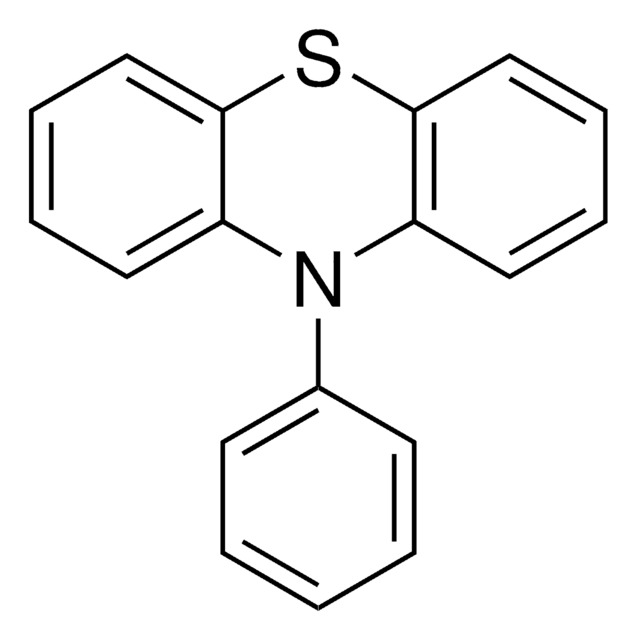All Photos(1)
About This Item
Empirical Formula (Hill Notation):
C12H9NO
CAS Number:
Molecular Weight:
183.21
Beilstein:
143234
EC Number:
MDL number:
UNSPSC Code:
12352100
PubChem Substance ID:
Recommended Products
Assay
≥99%
purified by
sublimation
mp
156-159 °C (lit.)
solubility
benzene: freely soluble(lit.)
chloroform: freely soluble(lit.)
diethyl ether: freely soluble(lit.)
ethanol: freely soluble(lit.)
petroleum ether: very slightly soluble(lit.)
SMILES string
N1c2ccccc2Oc3ccccc13
InChI
1S/C12H9NO/c1-3-7-11-9(5-1)13-10-6-2-4-8-12(10)14-11/h1-8,13H
InChI key
TZMSYXZUNZXBOL-UHFFFAOYSA-N
Looking for similar products? Visit Product Comparison Guide
General description
Phenoxazine dyes, including several Nile blue analogs, are known to localize selectively in animal tumors.
Application
Phenoxazine is a tricyclic 2′deoxycytidine analog that has been used to improve stacking interactions between heterocycles of oligonucleotide/RNA hybrids and to enhance cellular uptake.
Storage Class Code
13 - Non Combustible Solids
WGK
WGK 3
Flash Point(F)
Not applicable
Flash Point(C)
Not applicable
Personal Protective Equipment
dust mask type N95 (US), Eyeshields, Gloves
Choose from one of the most recent versions:
Already Own This Product?
Find documentation for the products that you have recently purchased in the Document Library.
Customers Also Viewed
W M Flanagan et al.
Nature biotechnology, 17(1), 48-52 (1999-01-27)
One of the major barriers to the development of antisense therapeutics has been their poor bioavailability. Numerous oligonucleotide modifications have been synthesized and evaluated for enhanced cellular permeation with limited success. Phenoxazine, a tricyclic 2' deoxycytidine analog, was designed to
C W Lin et al.
Cancer research, 51(4), 1109-1116 (1991-02-15)
The overall goal of our research is to develop effective new photosensitizers for tumor-selective photodynamic therapy. Phenoxazine dyes, including several Nile blue analogues, are known to localize selectively in animal tumors. Structural modifications yielded several series of analogues with substantially
Frédéric Bruyneel et al.
Chemistry (Weinheim an der Bergstrasse, Germany), 15(33), 8283-8295 (2009-07-23)
Laccases are members of the blue copper oxidases family found in nature. They commonly oxidise a wide range of phenol and aniline derivatives, which in turn are involved in oxidative coupling reactions. Yet, laccases remain rarely described as biocatalysts in
Michael J Rose et al.
Inorganic chemistry, 48(14), 6904-6917 (2009-06-02)
Three ruthenium nitrosyl-dye conjugates, namely, [((OMe)(2)bQb)Ru(NO)(Resf)] (RuNO-Resf), [((OMe)(2)bQb)Ru(NO)(Thnl)] (RuNO-Thnl), and [((OMe)(2)bQb)Ru(NO)(Seln)] (RuNO-Seln) have been synthesized using the tetradentate N4 dicarboxamido ligand H(2)(OMe)(2)bQb. Each nitrosyl of this series is conjugated to a phenoxazine-type heterotricyclic chromophore which has been systematically varied in
Guo-Xiang Li et al.
Journal of biochemical and molecular toxicology, 23(4), 280-286 (2009-08-26)
Phenothiazine (PtzNH) and phenoxazine (PozNH) can protect human erythrocytes against hemolysis induced by 2,2'-azobis(2-amidinopropane hydrochloride) (AAPH), a peroxyl radical supplier. However, an antioxidant may be a pro-oxidant to accelerate the oxidation in the presence of radicals. The aim of this
Our team of scientists has experience in all areas of research including Life Science, Material Science, Chemical Synthesis, Chromatography, Analytical and many others.
Contact Technical Service








